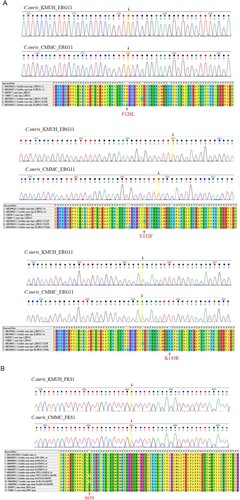Figures & data
Figure 1. Phylogenetic tree generated by Maximum likelihood analysis using (A) ITS and (B) D1/D2 region of the Candida auris strains with closely related Candida species. The percentages of replicate trees in which the associated taxa clustered together in the bootstrap test (10,000 replicates) are indicated at the branches. The scale bar indicates the nucleotide substitutions per site. Two isolates in the present study are highlighted in red and two isolates are related to C. auris as it falls in the same clade.

Figure 2. (A) Sequence alignments of ERG11 gene in C. auris isolates. (B) Sequence alignments of FKS1 hot spot 1 region in C. auris isolates. Mutations in ERG11 or FKS1 were not detected in either isolate.

Figure 3. Short tandem repeat genotypes of 44 Candida auris isolates. Unweighted pair group method with arithmetic averages dendrogram of both isolates (KMUH and CMMC) and representative isolates from the South Asian clade and four clades are shown. Abbreviations: UK, United Kingdom; SA, South Africa.

Table 1. Characteristics and antifungal susceptibility profiles of Candida auris isolates in Taiwan.
Figure 4. Distribution of reported C. auris cases in Southeast Asia and neighbouring regions/countries. Case counts were based on an epidemiological report [Citation22] and studies from Japan [Citation28], South Korea [Citation29], Taiwan [Citation14] (including the present study), China [Citation25], Hong Kong [Citation30], Malaysia [Citation10], Singapore [Citation12], Thailand [Citation11], Bangladesh [Citation31], and India and Pakistan [Citation5].
![Figure 4. Distribution of reported C. auris cases in Southeast Asia and neighbouring regions/countries. Case counts were based on an epidemiological report [Citation22] and studies from Japan [Citation28], South Korea [Citation29], Taiwan [Citation14] (including the present study), China [Citation25], Hong Kong [Citation30], Malaysia [Citation10], Singapore [Citation12], Thailand [Citation11], Bangladesh [Citation31], and India and Pakistan [Citation5].](/cms/asset/92956dd8-b1a2-4f8f-ab2d-11ac5efb22af/temi_a_2100280_f0004_oc.jpg)
Table A1. GenBank accession numbers, ERG11 and FKS1 genotypes, and clade information of representative strains included in this study.
Table A2. Sequences of primers used in the study.
